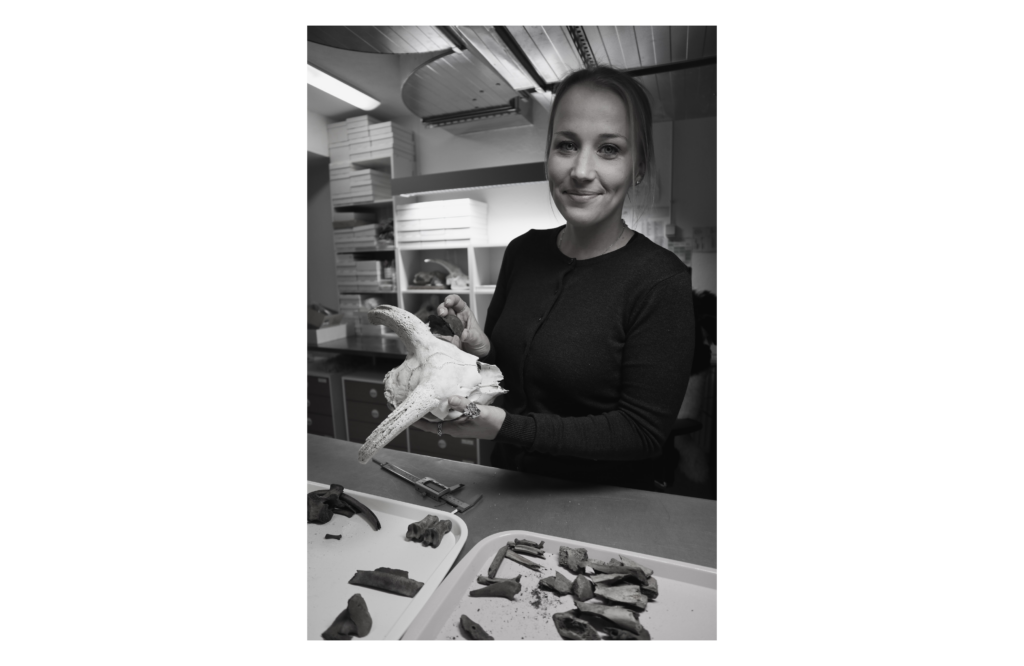Eve Rannamäe

Eve is a zooarchaeologist and currently an associate professor at the Department of Archaeology, University of Tartu (UT). In her doctoral thesis (UT) and during her MSCA funded post-doctoral project at the University of York (UK), she investigated sheep populations in Estonia and Northeastern Europe, using methods from morphometrics and archaeogenetics. Eve’s research on past animals and husbandry has also brought her to present-day, where she has been able to apply the zooarchaeological data to the research and conservation of the native sheep in Estonia. Eve is currently involved in three research projects. In two of them (BoNe and PRG29) she has added domestic cattle and goats to her study focus: their husbandry, exploitation, and development of populations during the Middle Ages and Modern Period. For example, she is interested in the oxen culture and its connections to Estonia’s northern neighbour Finland. Additionally, she is gathering a general overview for these time periods about animal husbandry, movement, trade, production and breed improvement in Estonia. In the third project (PSG492), her interests lie in Prehistory instead and in the roles both wild and domestic animals played in the people’s food habits.
In addition to her research, Eve currently supervises a BA and a PhD student at the UT, both in the field of zooarchaeology. She’s a team member at the Rõuge Ancient Farm project, where Viking Age building techniques and living environment are being studied through experimental archaeology.
Publications
- Rannamäe, E.; Lõugas, L.; Niemi, M.; Kantanen, J.; Maldre, L.; Kadõrova, N.; Saarma, U. (2016). Maternal and paternal genetic diversity of ancient sheep in Estonia from the Bronze Age to the Post-Medieval Period, and comparison with other regions in Eurasia. Animal Genetics, 47, 2, 208−218. https://doi.org/10.1111/age.12407
- Rannamäe, E.; Lõugas, L.; Speller, C.F.; Valk, H.; Maldre, L.; Wilczyński, J.; Mikhailov, A.; Saarma, U. (2016). Three Thousand Years of Continuity in the Maternal Lineages of Ancient Sheep (Ovis aries) in Estonia. PLOS ONE, https://doi.org/10.1371/journal.pone.0163676
- Maltby, M.; Pluskowski, A.; Rannamäe, E.; Seetah, K. (2019). Farming, Hunting, and Fishing in Medieval Livonia: The Zooarchaeological Data. In: Pluskowski, Aleksander (Ed.). Environment, Colonization, and the Baltic Crusader States: Terra Sacra I (137−173). Turnhout: Brepols Publishers.
- Pluskowski, A.; Makowiecki, D.; Maltby, M.; Rannamäe, E.; Lõugas, L.; Maldre, L.; Daugnora, L.; Blackh, S.; Müldnera, G.; Seetah, K. (2019). The Baltic Crusades and ecological transformation: The zooarchaeology of conquest and cultural change in the Eastern Baltic in the second millennium AD. Quaternary International, 510, 28−43. https://doi.org/10.1016/j.quaint.2018.11.039
- Pálsdóttir, A. H.; Bläuer, A.; Rannamäe, E.; Boessenkool, S.; Hallsson, J. H. (2019). Not a limitless resource: ethics and guidelines for destructive sampling of archaeofaunal remains. Royal Society Open Science, 6 (10). https://doi.org/10.1098/rsos.191059
- Rannamäe, E.; Andrianov, V.; Haak, A.; Järv, E.; Kreem, J.; Semjonov, A. (2019). A month in a horse’s life: healing process of a fractured third metatarsal bone from medieval Viljandi, Estonia. International Journal of Paleopathology, 24, 286-292. https://doi.org/10.1016/j.ijpp.2018.07.003
- Rannamäe, E.; Saarma, U.; Speller, C.; Teasdale, M. D.; Ärmpalu-Idvand, A. (2020). Retroviral analysis reveals the ancient origin of Kihnu native sheep in Estonia: implications for breed conservation. Scientific Reports, 10, 1-8. https://doi.org/10.1038/s41598-020-74415-z
- Lõugas, L.; Rannamäe, E. (2020). Investigating Animal Remains in Estonia. Archaeologia Lituana, 21, 132−141. https://doi.org/10.15388/ArchLit.2019.21.8
- Rannamäe, E.; Saarma, U.; Bläuer, A. (2022). Cultural influences on the castration age of cattle in the northern Baltic Sea region during the medieval and post-medieval periods. Journal of Archaeological Science, 137, 105517. DOI: 10.1016/j.jas.2021.105517.
- Rannamäe, E.; Saarma, U.; Kantanen, J.; Bläuer, A. (2023). Maternal genetic diversity of ancient goats in Finland and Estonia and comparison with extant northern European goat breeds. Animal Genetics. DOI: 10.1111/age.13281.
Talks
- Rannamäe, E.; Davis, S.; Lõugas, L.; Piliciauskiene, G.; Wilczyński, J.; Wojtal, P.; Ärmapalu-Idvand, A.; Junno, J-A.; Speller, C. (2018). Investigating the morphometrics of sheep in North-eastern Europe from the Early Neolithic period to modern native breeds. Abstracts: 13th ICAZ International Conference, Ankara-Turkey, 2nd-7th September 2018. Middle East Technical University – ODTÜ, 208.
- Rannamäe, E,; Teasdale, M.; Saarma, U.; Ärmpalu-Idvand, A.; Speller, C. (2019). The development and diversity of sheep populations in Estonia. 8th ICAZ AGPM – Archaeozoology, Genetics, Proteomics & Morphometrics: Muséum national dʼHistoire naturelle Paris, France October 17th-18th 2019.
- Rannamäe, E.; Bläuer, A.; Solala, H. (2019). Cultural influences on the castration time of cattle in the Baltic Sea Region during the Middle Ages and Early Modern Period. 25th EAA Annual Meeting (Bern, 2019) – Abstract Book: EAA 2019 Beyond paradigms, Bern, Switzerland, 4-7.09.2019. Bern: European Association of Archaeologists, 184.
- Rannamäe, E.; Saarma, U.; Ärmpalu-Idvand, A.; Teasdale, M.; Speller, C. (2019). Ancient retroviruses in aid of discovering and conserving aboriginal sheep lineages. 25th EAA Annual Meeting (Bern, 2019) – Abstract Book: EAA 2019 Beyond paradigms, Bern, Switzerland, 4-7.09.2019. Bern: European Association of Archaeologists, 410.
